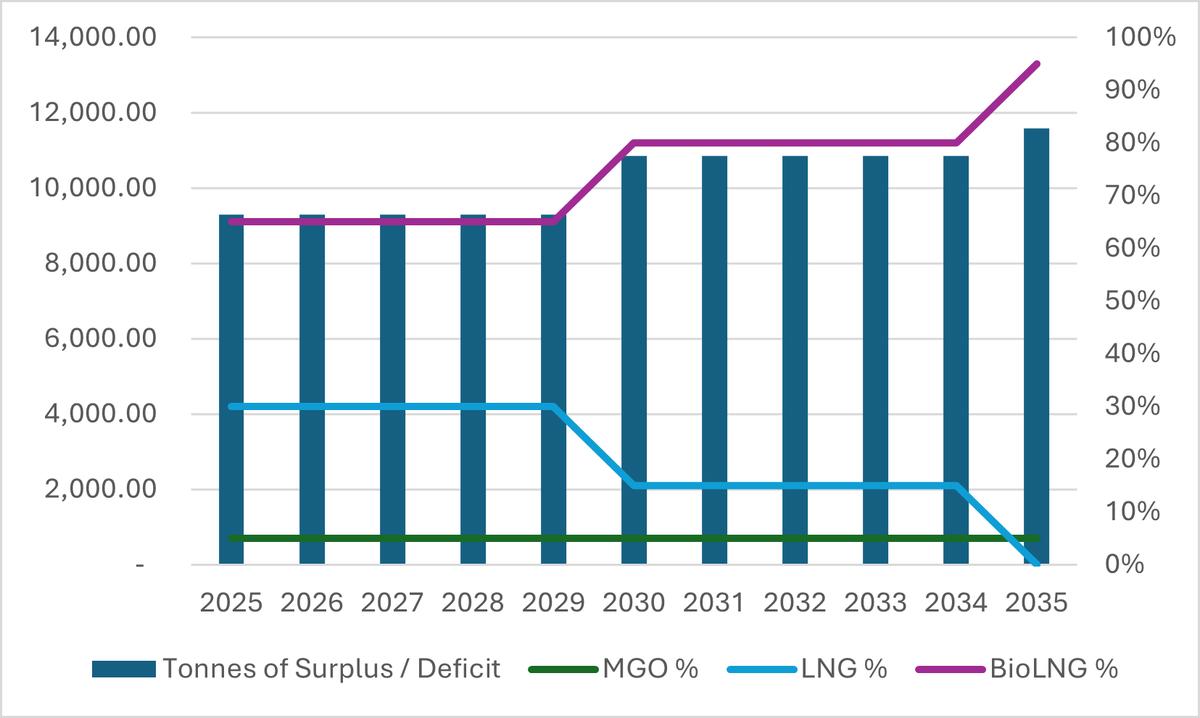Understanding FuelEU: How much bio-LNG do you really need?
A dual-fuel LNG vessel can earn a compliance surplus of nearly 9,300 mt/year by 2029 with 65% bio-LNG, a Lloyd's Register study has found.
 CHART: Ratios of bio-LNG and LNG in the fuel mix and their potential compliance surpluses. Lloyd's Register
CHART: Ratios of bio-LNG and LNG in the fuel mix and their potential compliance surpluses. Lloyd's Register
Under the FuelEU Maritime regulation, ships sailing between EU ports must limit their average well-to-wake (WtW) greenhouse gas (GHG) intensity to 89.34 grams of CO2-equivalent per megajoule (gCO2e/MJ) of energy from 2025. This represents a 2% reduction from the 2020 baseline of 91.16 gCO2e/MJ.
However, thanks to the regulation’s pooling compliance mechanism, surplus compliance from one ship can help cover deficits for others.
For example, a ship running on a fuel mix of 65% bio-LNG, 30% LNG and 5% marine gasoil (MGO) can generate a compliance surplus of 9,287 mt/year between 2025 and 2029. This surplus could offset the compliance deficits of up to 17 similar ships during the same period, according to Ryan Bax, lead consultant for business advisory at Lloyd’s Register.
It should be noted that the actual compliance surplus will depend on factors such as methane slip, which varies by LNG engine type and significantly affects calculations.
More bio but fewer ships covered
As stricter caps come into effect towards 2050, it becomes necessary to increase the proportion of bio-LNG in the fuel mix. For instance, Bax estimates that using a mix of 80% bio-LNG, 15% LNG and 5% MGO could potentially generate a surplus of around 10,500 mt/year between 2030 and 2034.
But with the GHG intensity cap dropping to 85.69 gCO2e/MJ (6% reduction) from 2030, this surplus will only be enough to cover the deficits of five other ships annually.
According to Bax's calculations, a vessel running on 95% bio-LNG and 5% MGO could potentially generate a compliance surplus of 11,576 mt/year. As the cap tightens to 77.94 gCO2e/MJ (14.5% reduction) from 2035, that surplus will only cover the vessel's own compliance.
When bio won't cut it
As thresholds become yet more stringent, with the ultimate target set at 18.23 gCO2e/MJ (80% reduction) by 2050, relying on bio-LNG alone will no longer suffice to offset deficits across a fleet.
Achieving compliance will require other measures with less GHG intensity, such as using e-LNG in existing LNG-capable vessels or investing in ships designed to run on other e-fuels.
By Konica Bhatt
Please get in touch with comments or additional info to news@engine.online






